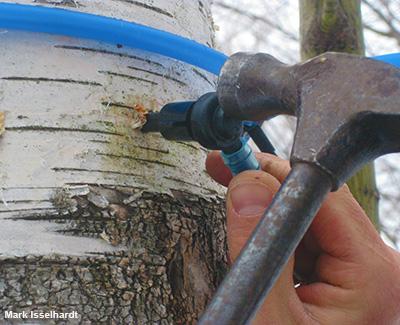Sustainable Tapping Guidelines for Birch Syrup Production in the Northern Forest

Maple syrup production, a vital part of the Northern Forest’s economy and working landscape, uses forests sustainably to produce a natural product and provide jobs, generate income, and create business opportunities that support families, communities, and businesses. However, with rising production costs, maple producers face increasing challenges in maintaining profitable operations. Adding birch syrup production can provide additional revenue. NSRC researchers developed science-based tapping guidelines and management practices for ecologically sustainable and profitable paper birch sap collection in the Northern Forest.
Researchers found the volume of nonconductive wood (NCW) generated by taphole wounds in paper birch trees was large, averaging 220 times the volume of the taphole wound. With these NCW volumes, minimum radial growth rates required for tapping birch trees to be sustainable when following standard tapping guidelines ranged from 0.32 to 0.38 cm per year. Modified tapping practices (increased dropline length, reduced tapping depth, etc.) or forest thinning can help increase the sustainability of tapping.
Optimum timing for tapping varied during the 2015 and 2016 seasons. Researchers found tapping trees after test tapholes installed in a few trees began to drip sap at a reasonable rate (a few drops per second) to be a reliable indicator of when trees should be tapped. Tapping somewhat early (when using vacuum) is not likely to significantly negatively impact yields, but waiting until the maple season concludes may result in significantly lower yields in some years. Producers can follow these guidelines to ensure that they use sustainable tapping practices to obtain the maximum possible sap yields from their birches.
